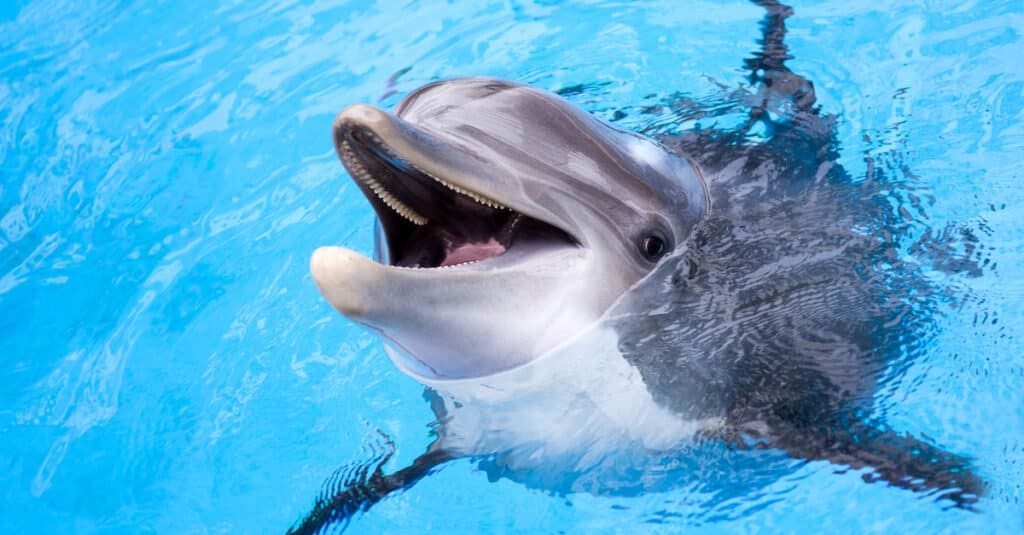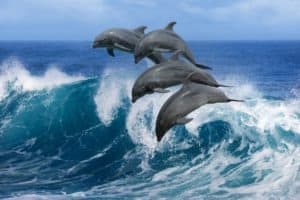The world is home to thousands of unique animals, with thousands more undiscovered. The primary reason there are many more undiscovered animals is because of how big the earth is and the fact that the ocean covers over 71% of the earth’s surface, and most of it remains unexplored. As such, it is almost impossible to know what creatures lie at the ocean’s depths. One of the most unique aquatic animals in the world is the dolphin.
Dolphins are aquatic mammals belonging to the suborder Cetacea. There are currently more than 40 extant species of dolphins. They are divided into four families: the oceanic dolphins (Delphinidae), the Indian river dolphins (Platanistidae), the brackish dolphins (Pontoporiidae), and the New World river dolphins (Iniidae). There are also several dolphin species belonging to the extinct baiji or Chinese river dolphin (Lipotidae) family.
Dolphins are also very social, often sticking together in groups (also called pods) of at least 12 other dolphins. It might be a wonder why they seem to enjoy playing around, chasing each other, and hitting objects into the sky, but dolphins do these as a way of practicing their hunting skills. Because of their size, it is interesting to wonder what their poop looks like, how often they poop, and whether or not their poop is harmful. Keep reading to discover these interesting facts and more.
Where Can Dolphins Be Found?

Dolphins are linked to the Indohyus, an extinct chevrotain-like ungulate from which they split about 48 million years ago.
©iStock.com/Elena Malysheva
Dolphins can be found in all the world’s oceans and are even more common in coastal areas. However, certain species prefer brackish habitats or freshwater river systems in South America or Asia. These animals get their name from the Greek word delphus, meaning womb, to signify that they are mammals. Dolphins are linked to the Indohyus, an extinct chevrotain-like ungulate from which they split about 48 million years ago.
Also, it is believed that dolphins are related to land mammals of the order of artiodactyls (even-toed ungulates). About 49 million years later, they eventually ventured into the ocean and five to ten million years after, they fully adapted to aquatic life.
What Do Dolphins Look Like?

Dolphins have brains bigger than humans’ and possess surprisingly complex communication methods.
©Irina No/Shutterstock.com
Most dolphin species can be recognized by unique patterns of notches and scars on their dorsal fin. In terms of color, they vary from light gray to dark gray on their backs which lightens to white underneath their jabs. One of their most distinctive qualities is their intelligence, ranking amongst the most intelligent animals in the world. These cute creatures have brains bigger than that of humans and possess surprisingly complex communication methods. However, they are not as smart as humans as their brains have relatively small prefrontal cortexes and smaller hippocampus.
What Does Dolphin Poop Look Like?
Other cetaceans, including all species of whales and porpoises, remove waste from their bodies in one way or another, either through vomiting or pooping. However, pooping is the most common of the two, and dolphins are not exempted from the act. Dolphin poop leaves the body of dolphins in a brown liquid form. It can float at the top of the sea or close to the water’s surface and have the appearance of a plum cloud in the water.
The amount of food a dolphin eats varies depending on its size and species. However, these creatures reportedly eat as much as 2% to 10% of their body weight daily. Keep in mind that the average dolphin size is at least 90 pounds, while the biggest dolphin species, the killer whales, weigh up to 10 tons (sometimes more), and grow as long as 30 feet.
Food must first be digested in the stomach before moving through the small intestine and being eliminated as poop through the anal tract. The excretory systems of dolphins are identical to that of many other mammalian species.
What Do Dolphins Eat?

Dolphins consume a wide range of fish, as well as squid, shrimp, jellyfish, and octopuses.
©iStock.com/SValeriia
Dolphins are primarily carnivorous animals, meaning they feed on other smaller animals. Dolphins consume a wide range of fish, as well as squid, shrimp, jellyfish, and octopuses. The kinds of fish and other animals that dolphins eat vary, depending on the species, its habitat, and other fauna that lives there. For instance, studies show that bottlenose dolphins also eat eels, hake, and mullet fish, and dusky dolphins off the coast of South America eat substantially more anchovies.
Echolocation is the primary method used by most dolphins to find food. They may find fish by listening to the clicking sounds they create. These creatures will circle and pursue fish that they can all eat together, only opening their mouths to catch it. They occasionally smash large fish against the water’s surface to split them up if they are too large to consume whole. Meanwhile, baby dolphins are primarily dependent on their mothers for milk. As the infant grows, it will eat up to 30 pounds of food per day while hunting prey with the help of its family. You will hardly ever witness a young dolphin go on a solo feeding expedition.
Is Dolphin Poop Harmful?
There is no known negative effect of dolphin poop on people. Considering how diluted dolphin excrement is by the ocean, many people often do not even recognize it when they see it. It is preferable to avoid it, though, much like with other animal poop. There are no health dangers involved with swimming in a dolphin-infested part of the ocean as long as you stay out of dolphin-poop-contaminated water.
Up to 50% of dolphin’s poop can contain a significant quantity of energy, which is crucial for the ecosystem of the ocean as well as the healthy development and growth of numerous species like phytoplankton and fish that depend on consuming them. In other words, dolphin poop is necessary to maintain a balance in the ocean’s ecosystem.
Up Next:
Dolphin Teeth: Everything You Need to Know
The photo featured at the top of this post is © iStock.com/savilleization
Sources
- Animal Vivid, Available here: https://animalvivid.com/do-dolphins-poop-and-pee/
- Euronews.green, Available here: https://www.euronews.com/green/2022/07/05/dolphin-poo-plays-significant-role-in-helping-coral-reefs-survive-says-new-study
- Whale Facts, Available here: https://www.whalefacts.org/do-dolphins-poop/
Thank you for reading! Have some feedback for us? Contact the AZ Animals editorial team.






